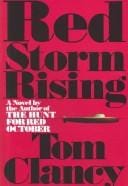Red Storm Rising: A Deep Dive into Tom Clancy’s Cold War Epic
Discover the plot, themes, and lasting impact of Tom Clancy’s Cold War novel Red Storm Rising in this in-depth analysis.

Introduction
When Tom Clancy and co-author Larry Bond released Red Storm Rising in 1986, the book rocketed up bestseller lists and solidified Clancy’s reputation as the undisputed master of the modern military technothriller. Unlike the author’s Jack Ryan series, this standalone novel drops readers into a meticulously researched World War III scenario fought mainly across the North Atlantic and central Europe. Nearly four decades later, the story remains essential reading for fans of high-stakes action, geopolitical strategy, and pulse-pounding realism.
Plot Overview
The novel opens with a devastating terrorist attack on a key Soviet oil refinery, pushing the already energy-starved USSR toward economic collapse. Facing domestic turmoil, the Politburo devises a bold plan: seize Middle Eastern oil fields by force. To distract NATO, the Soviets launch “Operation Red Storm,” a massive conventional assault on Western Europe. What follows is a sprawling, multi-theater conflict told through interwoven perspectives in the air, on land, beneath the sea, and inside command centers on both sides of the Iron Curtain.
Clancy structures the story in short, propulsive chapters that hop from U.S. Navy frigates dodging cruise missiles in the Norwegian Sea to West German armored divisions battling Soviet tanks along the Fulda Gap. Meanwhile, intelligence analysts in Washington and Moscow struggle to decode enemy intentions before the conflict spirals into nuclear annihilation. The result is a gripping, day-by-day chronicle of a hypothetical global war that feels chillingly plausible.
Main Characters and Multiple Perspectives
Part of what makes Red Storm Rising so engaging is its ensemble cast. Clancy eschews a single protagonist in favor of a broad mosaic of soldiers, sailors, aviators, and policymakers. Key figures include Commander Dan McCafferty, whose sonar team hunts Soviet submarines with cutting-edge technology; Air Force Lieutenant Michael Edwards, defending Iceland’s strategically vital airbase Keflavík; and Colonel Pavel Alekseyev, a seasoned Soviet officer who grows increasingly disillusioned with the Kremlin’s gamble. By humanizing actors on both sides, the novel underscores the personal costs of geopolitical brinkmanship.
Major Themes
The driving theme of the novel is the razor-thin margin separating peace from total war during the late Cold War era. Clancy illustrates how miscalculations—political, tactical, or technological—can escalate rapidly. Another theme is the primacy of information. From encrypted satellite links to airborne early-warning aircraft, whoever controls accurate data holds the battlefield advantage. Finally, the story critiques the notion of a “short, decisive war.” Every victory exacts an enormous price in lives and materiel, challenging the reader to reconsider the allure of militaristic quick fixes.
Technical Realism and Research
Clancy was famous for obsessive research, and nowhere is that more evident than in Red Storm Rising. Naval engagements rely on authentic sonar ranges, signal-processing algorithms, and anti-ship missile flight profiles. Ground operations feature genuine NATO doctrines, Warsaw Pact order of battle tables, and the latest tank armor composites of the 1980s. Even the novel’s AWACS intercept chatter mirrors real call signs and brevity codes. This painstaking accuracy immerses readers and earned the book praise inside actual military circles.
Historical Context
Published during a period of heightened East-West tensions—just before the Reykjavík Summit and the eventual thaw that led to the Soviet collapse—the novel resonated with contemporary anxieties. The Reagan administration was investing heavily in naval expansion and strategic defense. Meanwhile, NATO war planners routinely simulated scenarios strikingly similar to Clancy’s fictitious conflict. For civilian readers, the book offered an insider’s glimpse into exercises like Able Archer and REFORGER, demystifying how close the superpowers truly sat to the edge.
Impact on the Genre and Legacy
Red Storm Rising did more than entertain; it redefined expectations for military fiction. Its success sparked a wave of technothrillers from authors such as Larry Bond, Stephen Coonts, and Dale Brown, all eager to blend gadgetry with geopolitics. The novel also influenced real-world defense thinking; U.S. Naval Academy instructors reportedly used excerpts to illustrate combined-arms doctrine. Today, it stands alongside works like The Hunt for Red October and Flight of the Intruder as a cornerstone of late-20th-century war literature.
Why the Novel Still Matters
Although the Soviet Union dissolved in 1991, Red Storm Rising continues to feel relevant. Russia’s 21st-century military maneuvers in Crimea and the Arctic have re-focused attention on the North Atlantic. Meanwhile, the novel’s cautionary tale about resource scarcity mirrors modern concerns over energy security and climate-driven conflict. Reading the book today offers insight into how conventional warfare might unfold between peer competitors—an unsettling scenario that strategic planners still grapple with.
Adaptations and Pop-Culture Influence
The novel was never turned into a feature film, largely because its globe-spanning battle scenes would have required a blockbuster budget. However, its influence permeates video games and simulations. The 1988 MicroProse strategy game Red Storm Rising let players command submarines in the Atlantic, while elements of the storyline inspired later franchises like Battlefield and Call of Duty. Tabletop wargamers also embraced the book, adapting its engagements into scenarios for systems such as Command Decision and Harpoon.
Conclusion
With its blend of meticulous research, rapid-fire action, and sober reflection on the costs of war, Red Storm Rising remains a landmark achievement in military fiction. Tom Clancy and Larry Bond crafted a narrative that is both entertaining and educational, transporting readers to carrier flight decks, tank turrets, and situation rooms with equal authority. Whether you are a seasoned wargamer, a history buff, or simply love a well-told thriller, this Cold War epic deserves a place on your reading list.



